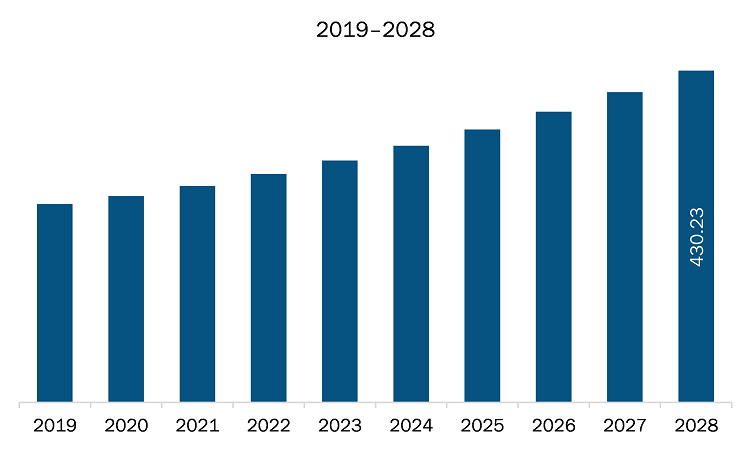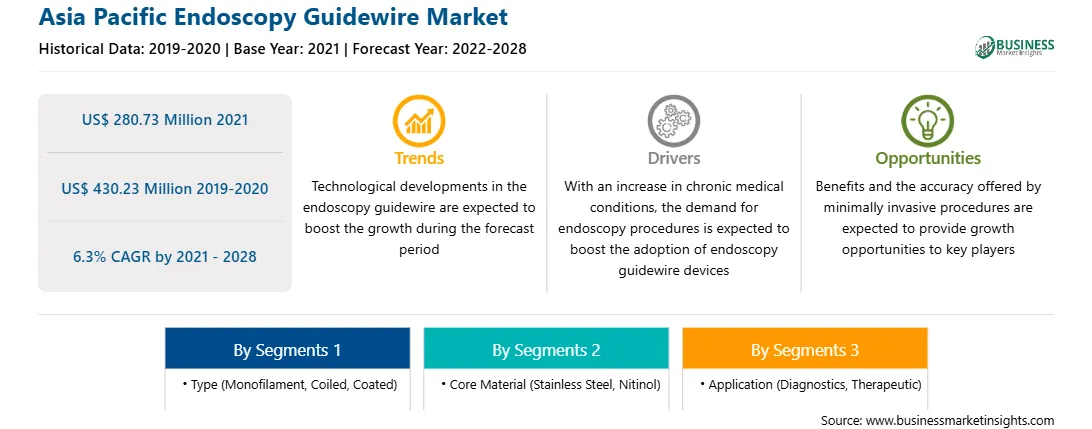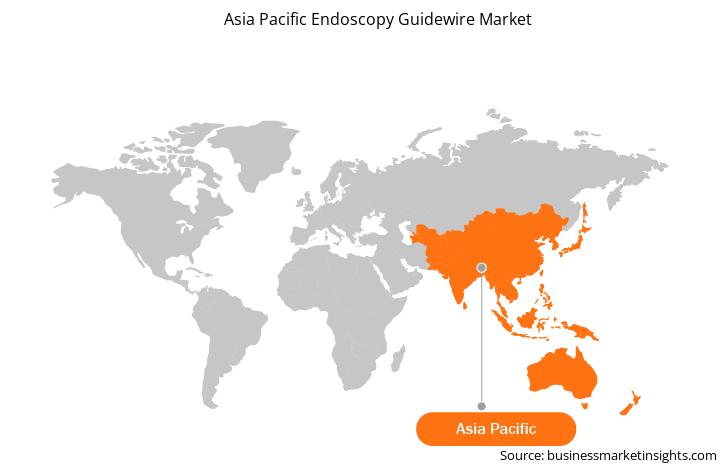Asia Pacific region includes countries such as India, China, Japan, and Rest of Asia Pacific. This region accounted for over 24% of the global endoscopy devices market owing to the large population countries such as China and India, increasing focus of market players, and introduction of new products in the country. Gastric cancer is a heterogeneous disease with large variations across geographical regions. Although the global incidence of gastric cancer is declining, it remains highly prevalent in Asia as compared to the West. China is one of the countries with the highest incidence of gastric cancer, and accounts for over 40% of all new gastric cancer cases in the world. Gastric cancer is the third leading cause of cancer mortality in China. Gastric cancer in Chinese patients is different from that occurring in the West and is a significant health burden. Moreover, there is currently no internationally accepted standard treatment regimen and clinical practice varies widely across countries. With the development of medical technology and wide application of more and more novel technologies, evidence-based approaches in combination with the strengths of various treatments will be the key to multidisciplinary management of gastric cancer for ultimately improving the outcomes and quality of life of these patients. GI endoscopy is very popular in China, and almost any diagnostic and therapeutic endoscopy can now be conducted in all major hospitals of the country. The annual number of cases handled by main hospitals in Beijing, for example, is roughly estimated at as many as 200,000. At least 5000 doctors in China are using the endoscope to diagnose and treat GI diseases: among these doctors, gastroenterologists account for 90%, with surgeons performing only 10% of cases. Screening programs have been effective in reducing the mortality rate of cancer in China, through early detection. The rate of incidence prevalence is higher in the rural areas of China as compared in the urban population. Also, the screening procedure is expensive, making it unaffordable for the rural population. Hence, a novel swallow able, disposable, soft-tethered, endoscopic capsule, with the aim of enabling cost effective gastroesophageal cancer screening in rural areas has been developed by The Vanderbilt Institute for Global Health (VIGH).
Countries in Asia-Pacific are expecting to witness huge challenge due to growing COVID-19. Considering the economic operations and geographic condition, the outbreak of disease has affected on medical tourism, manufacturer of medical equipment, accessories and other problems posed by shortage of healthcare infrastructure in Asia-Pacific low-income countries. After the first case in December 2019, in Wuhan, China, the coronavirus has spread to at least 180 countries and regions. To prevent the spread of disease, restrictive measures have been taken in countries such as India, South Korea, Singapore, Malaysia, and by the Philippines. According to WHO, due to the rapidly changing risk of COVID-19 affected countries and constantly controlling outbreak trends, any additional health measures are likely to significantly interfere with international travel and trade. This pandemic has affected gastrointestinal endoscopy practice across India to a vast extent. As compared to usual practice, 75.4 % of units were performing < 10 % endoscopy procedures only. The major reasons for the decrease in endoscopy procedures during the COVID-19 pandemic were fewer patients coming to the hospital due to government-mandated national lock-down, endoscopists themselves limiting the number of procedures due to the latest guideline recommendations for avoiding routine endoscopies, limiting contact with patients due to the fear of getting exposed, difficulty in managing usual patient volumes due to reduced availability of staff due to lockdown and in at least one-third, reduction in endoscopic procedures was due to advice from hospital management to avoid routine endoscopy procedures, which were in a stand-by mode for the potential surge and hence were limiting any elective procedures. Countries such as Japan and Australia are conducting virtual international conferences to anticipate the impact of COVID-19 on medical devices related industry in the Asia Pacific. China is specifically facing issues with the pandemic, leading to disruption of the supply chain, projected losses in revenue, marketing, and sales within all industries, especially the medical device industry, as well as the concerns of health within the production units and other public places. However, the countries such as India is conducting vaccination drive for the age group wise including the people within age group of 18 to 44, and 45 years and above. The country has also initiated testing of vaccine of the children which is expected to have and positive impact on the market.

Strategic insights for the Asia Pacific Endoscopy Guidewire provides data-driven analysis of the industry landscape, including current trends, key players, and regional nuances. These insights offer actionable recommendations, enabling readers to differentiate themselves from competitors by identifying untapped segments or developing unique value propositions. Leveraging data analytics, these insights help industry players anticipate the market shifts, whether investors, manufacturers, or other stakeholders. A future-oriented perspective is essential, helping stakeholders anticipate market shifts and position themselves for long-term success in this dynamic region. Ultimately, effective strategic insights empower readers to make informed decisions that drive profitability and achieve their business objectives within the market.

| Report Attribute | Details |
|---|---|
| Market size in 2021 | US$ 280.73 Million |
| Market Size by 2028 | US$ 430.23 Million |
| CAGR (2021 - 2028) | 6.3% |
| Historical Data | 2019-2020 |
| Forecast period | 2022-2028 |
| Segments Covered |
By Type
|
| Regions and Countries Covered | Asia-Pacific
|
| Market leaders and key company profiles |
|
The geographic scope of the Asia Pacific Endoscopy Guidewire refers to the specific areas in which a business operates and competes. Understanding local distinctions, such as diverse consumer preferences (e.g., demand for specific plug types or battery backup durations), varying economic conditions, and regulatory environments, is crucial for tailoring strategies to specific markets. Businesses can expand their reach by identifying underserved areas or adapting their offerings to meet local demands. A clear market focus allows for more effective resource allocation, targeted marketing campaigns, and better positioning against local competitors, ultimately driving growth in those targeted areas.

The endoscopy guidewire market in APAC is expected to grow from US$ 280.73 million in 2021 to US$ 430.23 million by 2028; it is estimated to grow at a CAGR of 6.3% from 2021 to 2028. Government initiatives have been proved to be an essential aspect for the growth of technology and the demand for any product in the market. To make endoscopic procedures accessible and beneficial to the patients, various government bodies have laid various initiatives supporting endoscopy devices. For instance, in July 2019, the Endoscopy Action Plan, implemented by the Queensland Government, was aimed toward improving the health of Queenslanders by means of delivering sustainable access to better quality gastrointestinal endoscopy services. The need for gastrointestinal endoscopy has been increasing rapidly owing to the national bowel screening program and a growing geriatric population. As per the plan, US$ 160 million would be invested over four years to deliver better services and improve access across the Queensland health system. Under the project, the services will be expanded to provide 50,000 more endoscopy procedures. Due to the implementation of this plan, the waiting time for endoscopy procedures has significantly reduced, and better services have been made available across the state. Moreover, the Gastroenterological Society of Australia (GESA) and the Australian Gastrointestinal Endoscopy Association (AGEA) established the National Endoscopy Training Initiative (NETI). This program was established to improve the quality and safety of colonoscopy and coordinate colonoscopy training in Australia. According to the program, comprehensive series of national, formalized, and standardized colonoscopy workshops are being conducted by experienced and highly qualified supervisors. In addition, standards are being laid down by NETI to be followed by individual endoscopists. Favorable government initiatives coupled with suitable policies are the major factors driving the growth of the market.
Based on type, the market is segmented into monofilament, coiled, coated. In 2020, the coated segment held the largest share APAC endoscopy guidewire market. Based on core material, the market is divided into stainless steel and nitinol. In 2020, the stainless steel segment held the largest share APAC endoscopy guidewire market. Based on application, the market is segmented into diagnostics and therapeutic. In 2020, the therapeutic segment held the largest share APAC endoscopy guidewire market.
A few major primary and secondary sources referred to for preparing this report on the endoscopy guidewire market in APAC are company websites, annual reports, financial reports, national government documents, and statistical database, among others. Major companies listed in the report are Boston Scientific Corporation
The Asia Pacific Endoscopy Guidewire Market is valued at US$ 280.73 Million in 2021, it is projected to reach US$ 430.23 Million by 2028.
As per our report Asia Pacific Endoscopy Guidewire Market, the market size is valued at US$ 280.73 Million in 2021, projecting it to reach US$ 430.23 Million by 2028. This translates to a CAGR of approximately 6.3% during the forecast period.
The Asia Pacific Endoscopy Guidewire Market report typically cover these key segments-
The historic period, base year, and forecast period can vary slightly depending on the specific market research report. However, for the Asia Pacific Endoscopy Guidewire Market report:
The Asia Pacific Endoscopy Guidewire Market is populated by several key players, each contributing to its growth and innovation. Some of the major players include:
The Asia Pacific Endoscopy Guidewire Market report is valuable for diverse stakeholders, including:
Essentially, anyone involved in or considering involvement in the Asia Pacific Endoscopy Guidewire Market value chain can benefit from the information contained in a comprehensive market report.